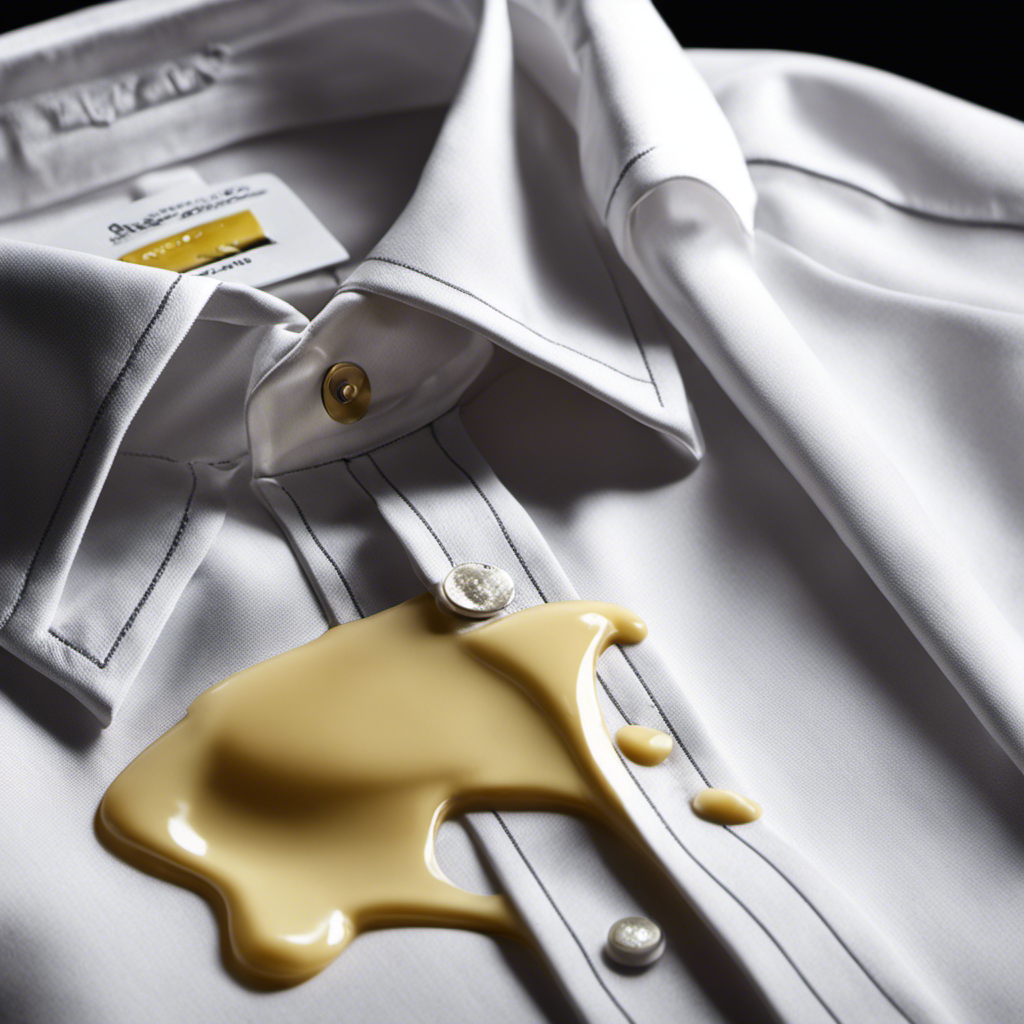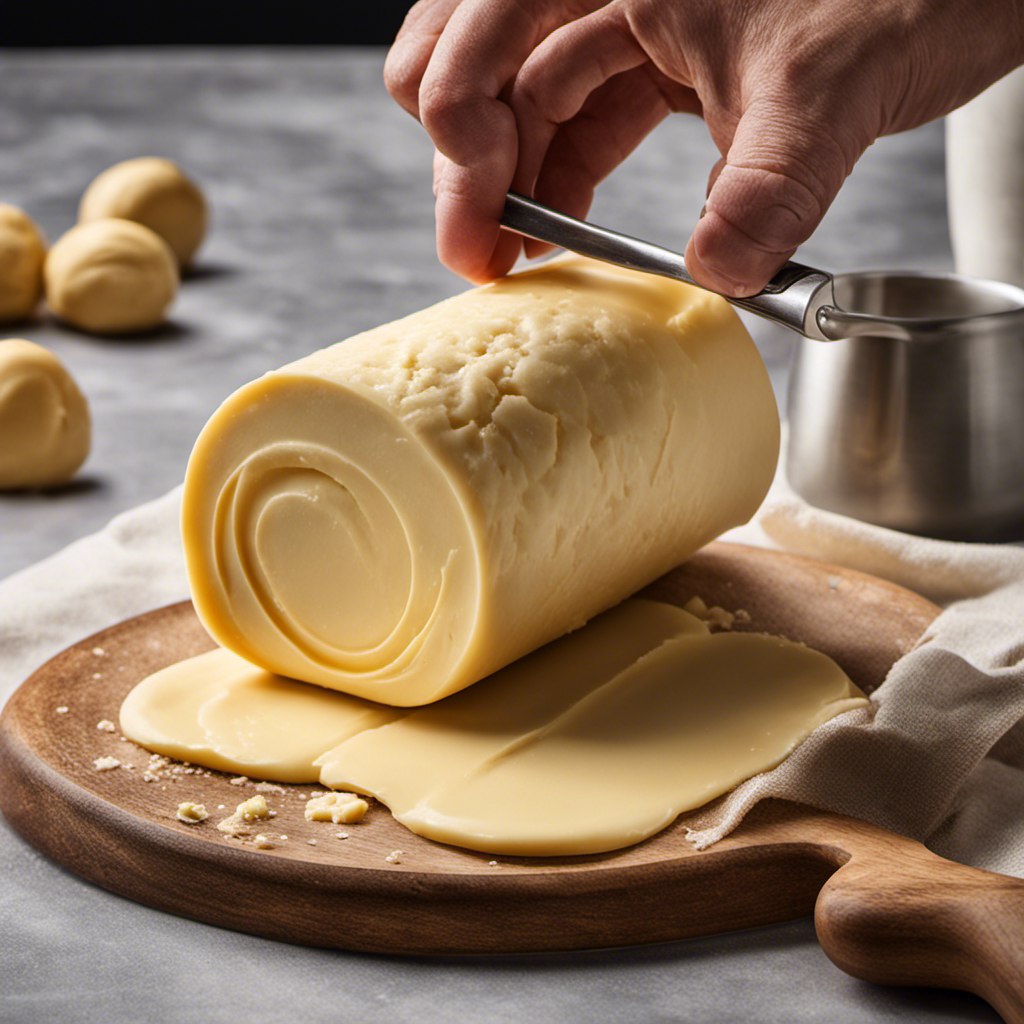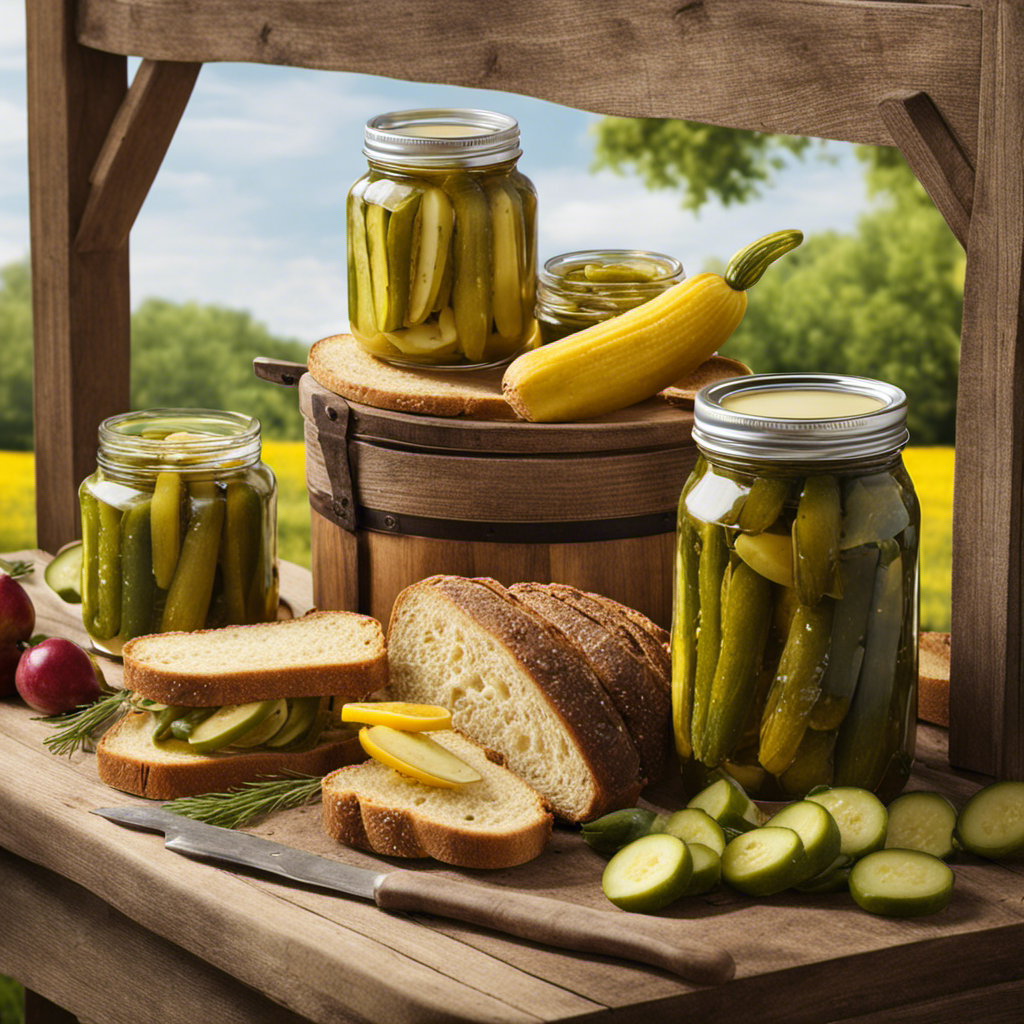Choosing between salted, unsalted, or lightly salted butter depends on your cooking or baking needs. Use unsalted butter for baking and recipes where you want full control of salt, ensuring your dish’s flavor is precise. Opt for salted butter when spreading on bread or adding to savory dishes, as it enhances taste and lasts longer. Lightly salted butter offers a balanced, subtle flavor, ideal for delicate dishes. For more tips tailored to your culinary projects, keep exploring these options.
Key Takeaways
- Use unsalted butter for baking to control salt levels and achieve a pure, dairy flavor.
- Opt for salted butter when spreading on bread or in savory dishes to enhance flavor and prolong shelf life.
- Choose “lightly” salted butter for a subtle saltiness that balances flavors in baked goods and spreads.
- Substitute salted for unsalted butter by reducing added salt in recipes to avoid over-salting.
- Store all butter types properly in airtight containers in the refrigerator to maintain freshness and flavor.
Understanding the Composition and Flavor Profiles of Different Butter Types
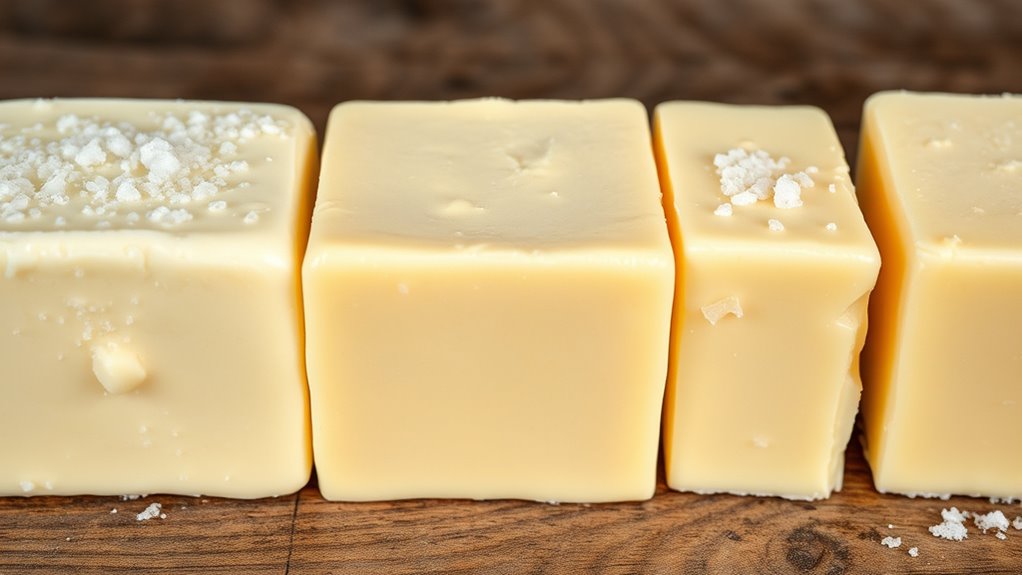
Understanding the composition and flavor profiles of different butter types is essential when choosing the right one for your cooking or baking. Butter manufacturing influences the fat content, moisture level, and salt addition, shaping each type’s flavor. Salted butter contains added salt, which enhances flavor and acts as a preservative, impacting butter storage and shelf life. Unsalted butter, made without salt, offers a purer dairy taste, making it ideal for baking where you control salt levels. Lightly salted butter falls between these two, with less salt for subtle flavor. Recognizing these differences helps you select the best butter for your recipe and storage needs. Proper butter storage, such as refrigeration and airtight containers, preserves its quality regardless of type. Understanding the differences in butter composition ensures you achieve peak flavor and freshness in your culinary creations.
Best Uses for Unsalted Butter in Baking and Cooking
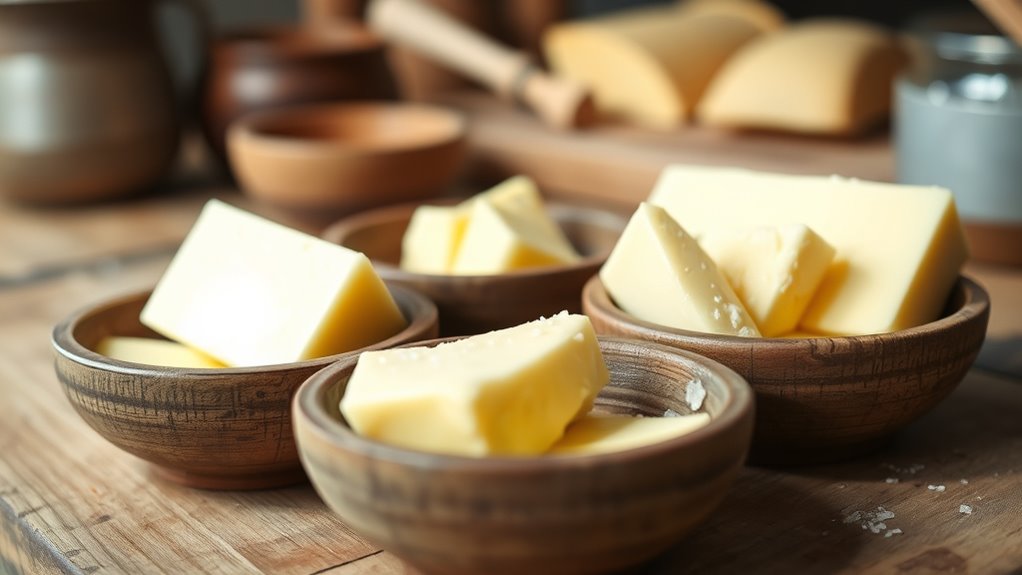
Unsalted butter is often the preferred choice for baking and cooking because it allows you to control the salt content in your recipes. Its fresh, pure flavor makes it ideal for pastries, cookies, and sauces where salt can influence taste. When storing butter, keep it in an airtight container in the refrigerator to maintain freshness and prevent absorption of odors. Unsalted butter also works well as a dairy alternative in vegan or lactose-free baking, providing richness without added salt. Use it for sautéing vegetables or making silky sauces, where precise salt levels matter. Since it lacks preservatives, unsalted butter benefits from careful butter storage, ensuring superior quality for your culinary creations. Its versatility makes it a staple for both sweet and savory dishes.
When to Choose Salted Butter for Spreading and Savory Dishes
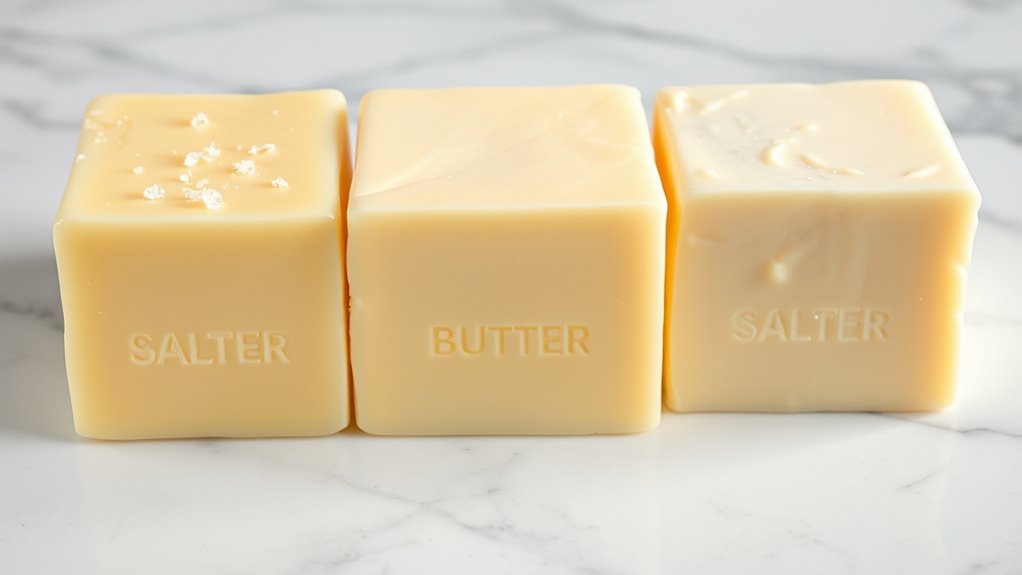
Salted butter is the ideal choice when you’re spreading butter on bread, toast, or muffins because its added salt enhances flavor and provides a satisfying, savory taste. When selecting butter for spreading, consider how butter storage affects freshness; salted butter’s longer shelf life makes it more convenient for everyday use. Proper butter packaging, such as foil or paper wrapping, helps maintain flavor and prevents spoilage. Salted butter also works well in savory dishes like sautéed vegetables or pan sauces, where the salt boosts overall flavor. Using salted butter means you won’t need to add extra salt, simplifying recipes and seasoning. Its moisture content also influences how well it melts and spreads, impacting overall culinary use. Keep it refrigerated and properly wrapped to preserve quality. This makes salted butter a practical, flavorful choice for spreading and savory applications.
The Role of “Lightly” Salted Butter in Balancing Flavor
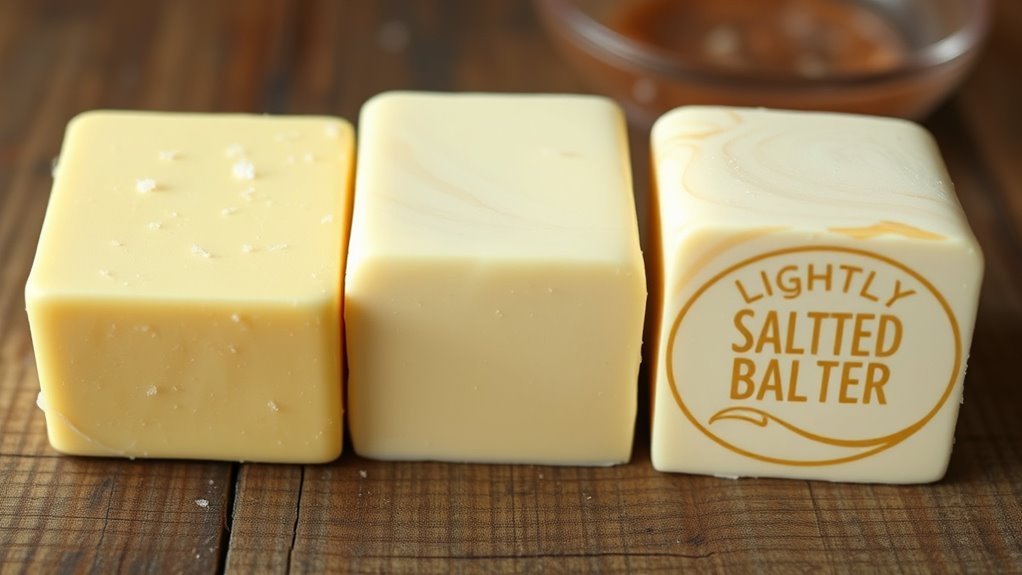
Lightly salted butter offers a subtle enhancement to dishes by adding just enough salt to boost flavor without overpowering other ingredients. This makes it ideal for balancing flavors, especially when you want a hint of seasoning without overwhelming your recipe. Proper butter storage is key to maintaining freshness and preventing spoilage, ensuring your lightly salted butter stays flavorful. When purchasing, pay attention to butter packaging—airtight containers help preserve the delicate balance of salt and butter quality. Using lightly salted butter allows you to control seasoning more precisely, making it suitable for baked goods, sauces, and spreads where a gentle salt presence enhances overall taste. It’s a versatile choice that complements dishes without masking their natural flavors.
How to Substitute Between Different Butter Varieties in Recipes
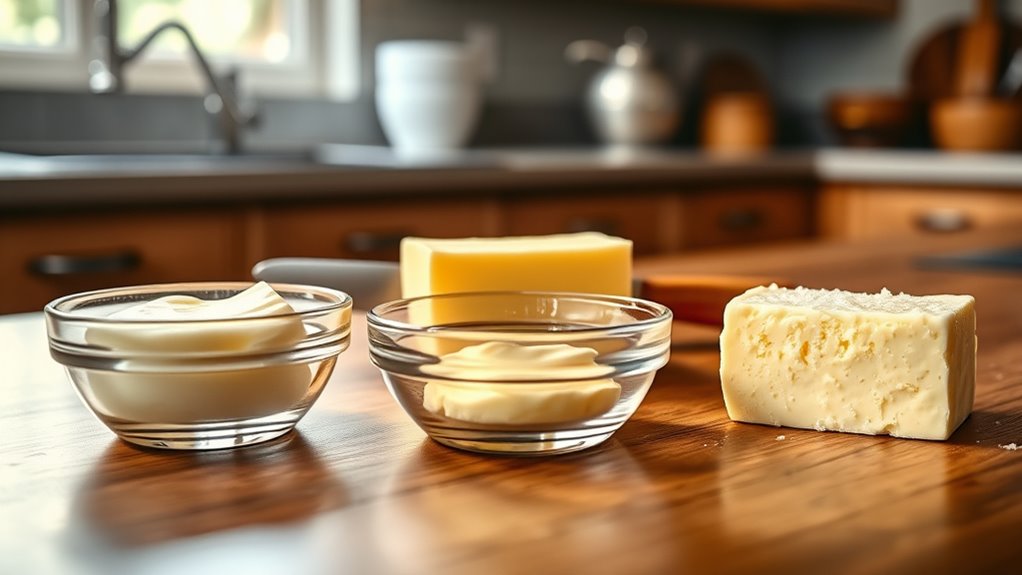
When swapping one type of butter for another in a recipe, understanding their differences helps guarantee your dish turns out just right. Unsalted butter offers control over salt content, while salted butter adds flavor and preserves freshness, influencing butter storage. If you substitute salted for unsalted, reduce added salt in the recipe accordingly. Consider dairy quality, as higher-quality butter provides better flavor and texture. When using butter with different salt levels, note that salted butter may slightly affect the final taste and consistency. If you’re substituting between butter varieties, keep in mind that butter storage conditions impact freshness, so always use well-stored, fresh butter for ideal results. Adjust salt and check for dairy quality to ensure your baked goods or dishes turn out as intended.
Tips for Selecting the Right Butter for Your Culinary Needs
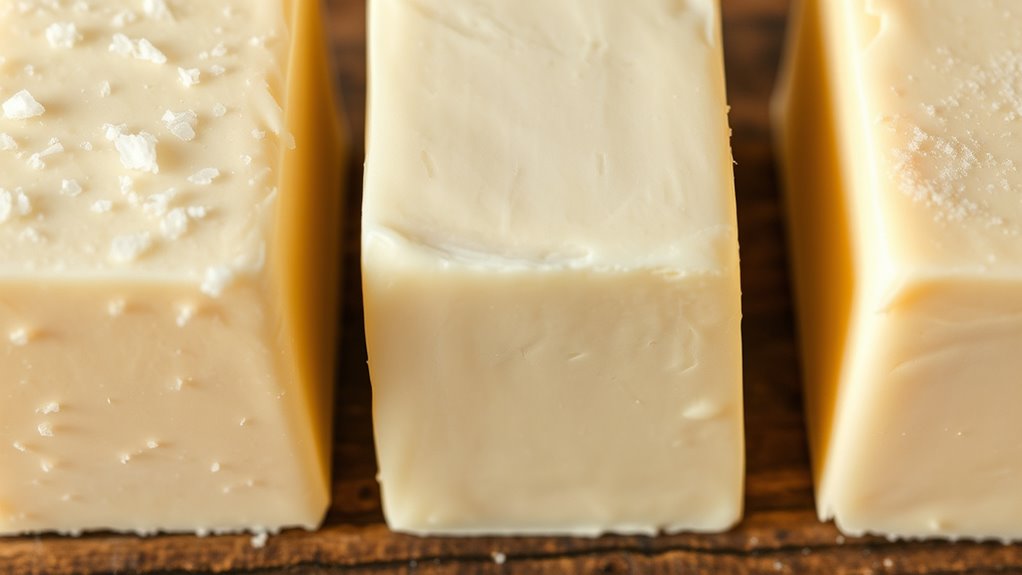
When choosing butter, consider the salt content and how it will impact your dish. Salted butter works well for spreading and finishing recipes, while unsalted is better for baking where precise salt control matters. Think about your cooking or baking needs to pick the butter that’ll give you the best flavor and texture. Proper salt levels are essential for achieving the desired taste and texture in your culinary creations.
Salt Content Considerations
Choosing the right butter depends heavily on its salt content, which can substantially influence your dish’s flavor. Salted butter adds a savory note, ideal for spreading or finishing dishes, while unsalted butter offers more control during cooking and baking. When selecting butter, consider how you’ll store it; proper butter storage in a cool, airtight container preserves freshness regardless of salt level. Also, check the butter packaging—some brands indicate salt content clearly, helping you choose accordingly. Lightly salted options provide a middle ground, offering some saltiness without overpowering delicate flavors. Your choice influences overall seasoning, so pick based on your recipe’s needs and your taste preferences. Understanding salt content ensures your dishes turn out just right, whether you’re baking or preparing a savory meal. Additionally, being aware of the role of salt in flavor balancing can help you make more informed choices to enhance your culinary creations.
Cooking and Baking Uses
Selecting the right butter for cooking and baking can considerably impact your results. Different butter production methods, such as churned or cultured, influence flavor and melting properties, making certain varieties better suited for specific tasks. For example, European-style butters with higher fat content melt smoothly and add richness to baked goods, while regional butter varieties like Irish or French butters can impart unique flavors. Unsalted butter is ideal for baking because it allows you to control salt levels precisely, whereas salted butter can enhance flavor in cooking or spreading. Lightly salted options work well in recipes where a hint of salt is desired without overpowering. Choosing the appropriate butter based on its production method and regional characteristics guarantees your culinary creations turn out just right. Additionally, understanding the regional characteristics of butter can help you select options that elevate your dishes with authentic flavors.
Frequently Asked Questions
Can I Substitute Salted Butter for Unsalted in Baking?
You can substitute salted butter for unsalted in baking, but keep in mind the flavor profiles. Salted butter adds salt, which enhances taste but can alter the sweetness or overall balance of your baked goods. If you use salted butter, reduce or omit added salt in the recipe. This way, you control the flavor, ensuring your baked treats turn out just right without unintended salty notes.
How Does Salt Content Affect Butter’s Melting Point?
You wonder how salt influence impacts butter’s melting point. Salt lowers the melting point, causing butter to melt faster at lower temperatures. This means that if butter contains more salt, it’ll soften and melt sooner during cooking or baking. Keep this in mind when adjusting recipes—more salt in butter can alter melting behavior, so you might need to tweak heat or timing to achieve the desired results.
Is “Lightly” Salted Butter Suitable for All Recipes?
You might wonder if “lightly” salted butter suits all recipes. It offers a subtle salt flavor variation and allows you to control salt content adjustment, making it versatile. However, for baking or delicate dishes, unsalted butter often works better since it provides a neutral flavor base. Use “lightly” salted butter when you want a hint of salt and more flavor flexibility, but keep in mind it may not be ideal for every recipe.
Does Salt Impact Butter’s Shelf Life?
Salt can impact butter’s shelf life through salt preservation, which helps inhibit bacterial growth and extends freshness. It also enhances flavor, making salted butter a tasty choice. However, too much salt might cause it to spoil faster if not stored properly. So, if you keep butter in a cool, airtight place, salt’s preservation benefits shine, and your butter stays good longer while boosting flavor.
Which Butter Type Is Best for Making Pastries?
You find that choosing the right butter for pastries is a fortunate coincidence; it’s about achieving the perfect butter texture and flavor enhancement. Unsalted butter is ideal because it allows you to control the salt, resulting in tender, flaky pastries with pure buttery richness. Its clean flavor blends seamlessly, ensuring your baked goods have the ideal consistency and taste. Using the right butter elevates your baking, making each pastry irresistibly delightful.
Conclusion
Choosing the right butter elevates your cooking. For example, a pastry chef might use unsalted butter for precise salt control, while a home cook spreads salted butter on toast for instant flavor. Understanding these nuances guarantees your dishes turn out just right, whether you’re baking delicate cookies or creating a savory sauce. By selecting the appropriate butter type, you harness the full potential of your ingredients, making every meal taste thoughtfully crafted.



